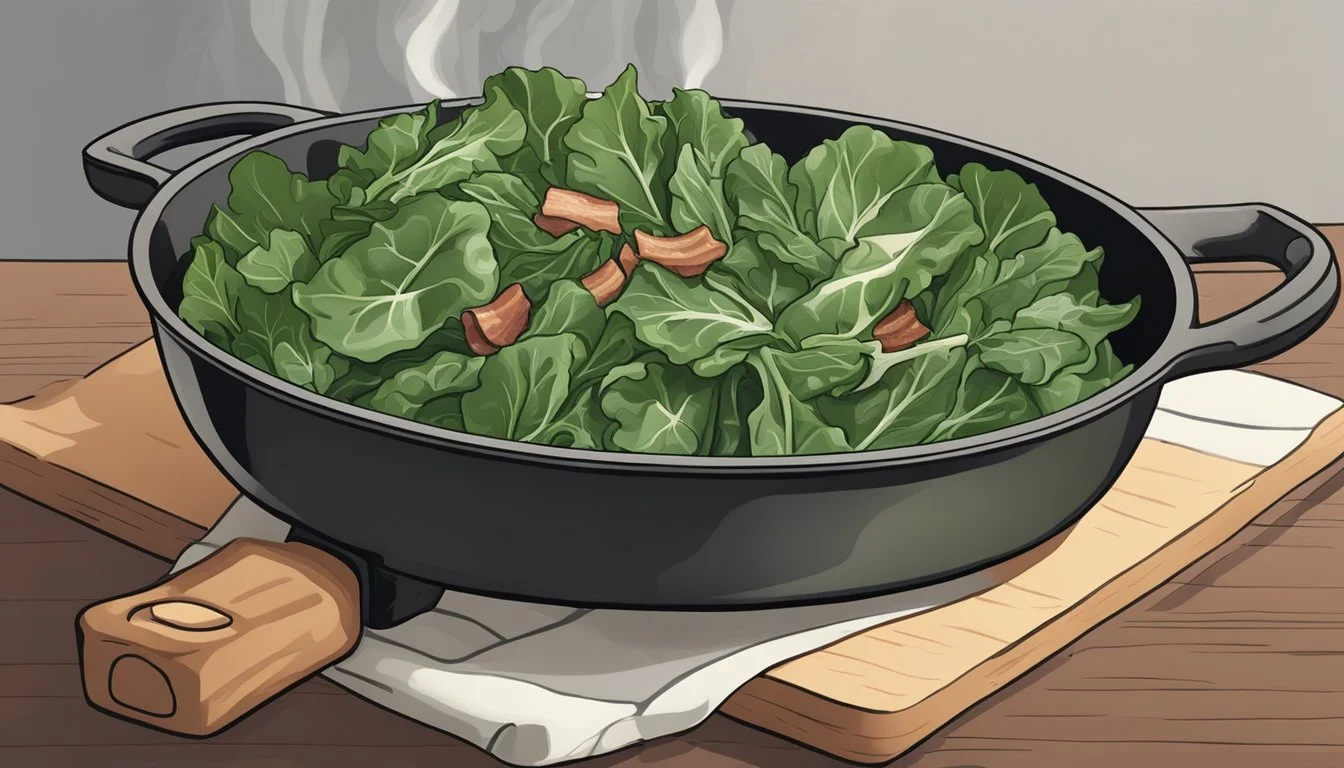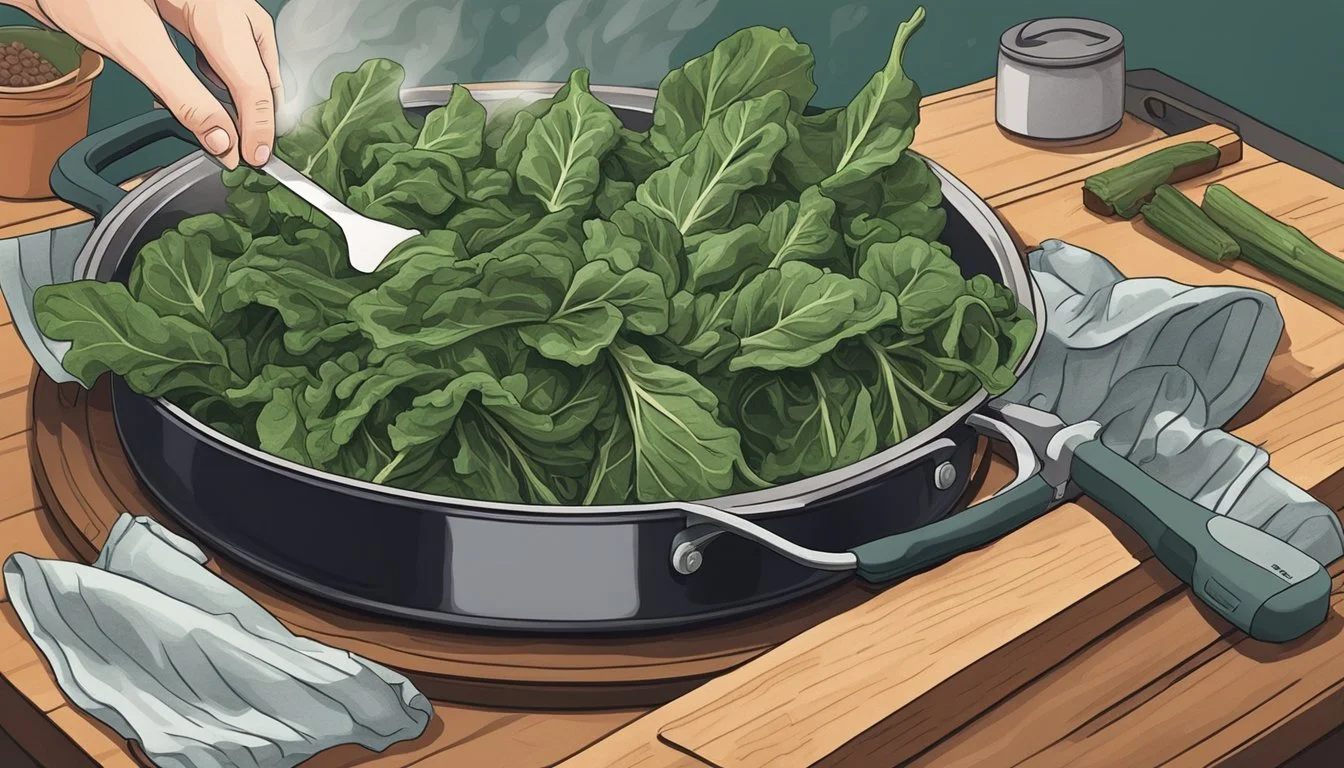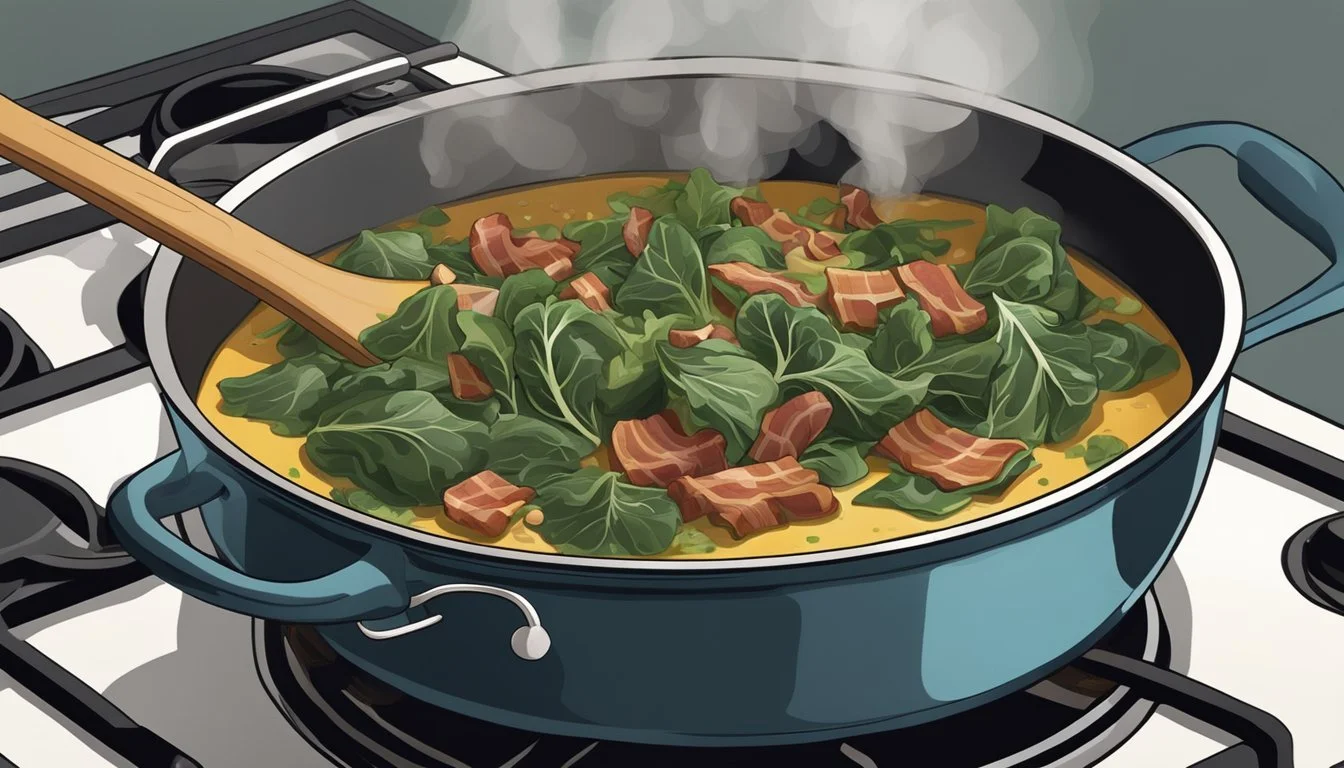How to Cook Texas-Style Collard Greens
A Step-by-Step Guide
Collard greens (how long do collard greens last?) hold a venerable place in Texas cuisine, where they are prepared with a bold twist, incorporating both time-honored cooking techniques and a dash of regional flavor. Texas-style collard greens bring a hearty, spicy depth to the Southern classic, often receiving a smoky undertone from the incorporation of brisket, jalapeños, or other local ingredients, a testament to the state's love for robust and meaty fare.
Cooking this Lone Star State dish involves a slow simmering process, allowing the flavors to meld and the leaves to achieve a tender, yet not overly soft, texture. These greens are usually bathed in a rich stock that is flavored with onions, garlic, and a generous amount of seasoning, resulting in a side that brilliantly complements the smoky and savory notes of Texan barbecues. The dish not only provides a nutritional punch but also stands as a celebration of Texas' agricultural bounty and its culinary ingenuity in transforming simple ingredients into complex and satisfying fare.
Origin and Cultural Significance
Collard greens, a robust leafy vegetable of the brassica family, trace their history to ancient civilizations but have become deeply embedded in Southern cooking traditions. In Texas, as in the broader American South, they are not just a side dish but a cultural symbol, steeply interwoven with history and community.
Texas and Southern Roots: While Texas shares many Southern influences, its version of collard greens is distinct with bold flavors. These greens have woven their way into the fabric of Southern cooking, adapted over time to integrate local ingredients and preferences.
New Year Tradition: Collard greens hold a special place in New Year celebrations, particularly in African American communities in the South. There's an enduring belief that these greens, often served alongside black-eyed peas and cornbread, herald prosperity and good fortune for the coming year.
Culinary Tapestry: In Texas, as in much of the South, collard greens are more than nourishment. They are served at family gatherings and festivals, embodying the soul of Southern cuisine. This leafy staple represents perseverance, and eating them is an act of honoring past struggles and looking forward to growth and strength.
Cultural Significance Example in Texas and Southern Cuisine Symbol of Prosperity Essential on New Year's Day for good fortune Culinary Staple Featured at family gatherings and community events Historical Roots Part of African and African American culinary heritage
With reverence for their past and enthusiasm for the flavors they bring to the table, collard greens remain a treasured element of the Southern culinary landscape.
Selecting and Preparing the Greens
In preparing Texas-style collard greens, selecting fresh, vibrant leaves and proper cleaning are crucial. Preparing the greens involves a thorough wash to remove any dirt, removing the tough stems, and chopping the leaves for even cooking.
Cleaning Collard Greens
Wash: Place the collard greens in a sink full of water. Swirl them around to loosen any dirt.
Rinse: Lift the greens out of the water, allowing the dirt to settle. Repeat until the water runs clear.
Inspection: Even pre-washed greens should be checked for remaining grit.
Stemming and Chopping Greens
Remove Stems: Firmly hold the leaf and strip away the tough stem.
Cut: Stack several leaves, roll them tightly, and cut into 1-inch thick strips for uniform cooking.
Storing Collard Greens
Refrigerator: Store unwashed greens in a loose plastic bag in the refrigerator for up to 5 days.
Freezer: Blanch the greens, shock in cold water, pat dry, and freeze flat in a single layer before transferring to a sealable bag.
Must-have Ingredients
For authentic Texas-style collard greens, leverage the following essentials:
Fat: Traditionally, rendered bacon fat or ham hocks provide richness and depth.
Acid: A splash of apple cider vinegar adds a tangy counterpoint to the greens' bitterness.
Seasoning: Kosher salt and a dash of sugar balance the flavor profile.
Substitutions and Variations
One can tailor the greens to their preference:
Greens Varieties: Mustard, turnip, or kale can substitute for collard greens.
Vegetarian Twist: Use smoked paprika or liquid smoke instead of meat for a similarly smoky flavor profile.
Spicing it Up: Add red pepper flakes or diced jalapeños for an extra kick.
Cooking Techniques
In preparing Texas-Style Collard Greens, mastering a few specific cooking techniques is crucial. The process involves a layered approach to simmering the greens, artfully combining seasonings for a rich flavor profile, and selecting the appropriate equipment for optimal cooking.
Simmering
To achieve the quintessential tender texture, collard greens should be simmered slowly. One starts by sautéing onions and garlic until translucent to create a flavorful base. Then, it's essential to incorporate a cooking liquid, typically water or broth, to the pot. The greens are submerged in this liquid and should be simmered over low heat for an extended period, commonly ranging from 45 minutes to 2 hours, depending on the desired tenderness.
Seasoning and Flavor Profiles
Texas-Style Collard Greens demand a robust flavor profile. Start with a foundation of salt and black pepper, then build complexity by adding apple cider vinegar for tanginess, crushed red pepper for heat, and smoked paprika for a smoky essence. Many recipes recommend incorporating brown sugar to balance the greens’ natural bitterness. Seasonings are typically added to the pot at the beginning of the simmering process to meld the flavors together.
Using the Right Equipment
The selection of the right pot is critical for cooking collard greens. A large stockpot ensures even cooking and enough space for the greens to simmer and soften. An Instant Pot can be an alternative, offering a faster cooking method while still delivering on tenderness. Regardless of the choice, the equipment must be capable of maintaining consistent low heat and should have a tight-fitting lid to keep the steam and flavors locked in during the cooking process.
Building the Dish
Creating Texas-Style Collard Greens involves a harmonious blend of smoked meats (What wine goes well with smoked meats?) for depth, a selection of foundational ingredients that pay homage to southern cuisine, and a careful layering of flavors. The process culminates in a dish rich with tradition and taste.
Foundational Ingredients
The base of Texas-style collard greens starts with fat and greens. Typically, the fat comes from smoked meats such as bacon, smoked ham hock, smoked turkey wings, or smoked turkey legs. These ingredients not only provide fat but also impart a deep, smoky flavor. The greens, specifically collard greens, need a thorough cleaning since they often carry grit.
Layering Flavors
Layering flavors begins with cooking the chosen smoked meat in a large pot to render out the fat and to build a fond. Once the meat is sufficiently browned, add chopped onions to caramelize in the fat, which introduces a sweetness to the dish. Following this, introduce chicken broth or chicken stock to deglaze the pot and incorporate the fond into the broth. Adding a splash of vinegar—preferably apple cider vinegar—and a touch of sugar balances the broth's savoriness with acidity and a hint of sweetness.
Combining Components
Once the broth is seasoned and simmering, the cleaned collard greens are added to the pot. They should be submerged in the liquid and left to cook down until they become tender. This can take upwards of an hour, which allows the flavors to meld fully. If desired, other side components like black-eyed peas can be prepared separately to complement the collard greens.
Final Touches
After the greens have stewed and the flavors have married, adjust the seasoning with salt and pepper to taste. Some cooks may choose to add additional vinegar for a brighter flavor or a pinch more sugar to balance. The greens should be textured and tender, with the smoked meat breaking apart. Serve hot as a side dish, or as a main dish often accompanied by cornbread, transforming the collard greens into the centerpiece of a traditional Southern meal.
Serving and Pairing
In this section, readers will discover the best ways to serve Texas-style collard greens and the variety of dishes that pair well with this Southern classic. Emphasis is placed on the traditional pot liquor, also known as potlikker, that accompanies the greens, enhancing the flavor of the dishes it is served with.
Accompaniments
Black-eyed peas: Often cooked in an Instant Pot, black-eyed peas are a customary side that complements the earthy taste of collard greens.
Cornbread: A buttermilk skillet cornbread pairs excellently; it helps in savoring the potlikker and adds a sweet contrast.
Grits: Creamy grits serve as a smooth and mellow counterpart to the hearty greens.
Okra: Typically fried or stewed, okra introduces a delightful texture contrast.
Mashed Potatoes: A classic side, mashed potatoes offer a creamy base for the greens and potlikker.
Collard greens can be served as a main dish, but more commonly, they are a side dish known for their versatility on the dinner table.
Presentation
The presentation of Texas-style collard greens should emphasize simplicity and comfort.
Servings: A typical serving of collard greens as a side dish is about one cup, but it can vary depending on the accompanying main dish.
Pot Liquor (Potlikker): Ensure to include a generous amount of potlikker when serving; it’s the richly flavored cooking liquid that's a soulful component treasured in Southern cuisine.
Make-Ahead: Collard greens are well-suited for make-ahead meals; their flavor often improves overnight, making them a convenient and delicious option.
The collard greens will usually be plated next to or beneath the main dish, with the potlikker drizzled over or served on the side for dipping.
Health and Nutrition
Collard greens are a nutritional powerhouse, packed with essential vitamins and minerals. They offer a rich source of vitamin A, which plays a critical role in maintaining healthy vision, skin, and immune function. Additionally, these leafy greens are an excellent source of vitamin C, crucial for growth, development, and repair of all body tissues.
In terms of mineral content, collard greens provide a significant amount of calcium, which is vital for bone health and maintaining a strong skeletal system. Despite their density in nutrients, collard greens are low in calories, making them an ideal ingredient for those monitoring their calorie intake for weight management or health reasons.
Here's a quick breakdown of the nutritional benefits:
Vitamin A: Enhances vision and immune function, supports skin health.
Vitamin C: Aids in collagen production, antioxidants support, boosts immunity.
Calcium: Essential for bone strength and cardiovascular function.
When cooking Texas-style collard greens, incorporating healthy cooking methods can maximize the vegetable's nutritional value. For example, using olive oil instead of butter can add heart-healthy fats, and opting for low-sodium broth or water as a cooking liquid can reduce overall salt intake.
By including collard greens in their diet, individuals can make significant strides towards fulfilling their recommended daily intake of several key nutrients, while also enjoying the flavors of a Southern staple dish. It's clear that this vegetable should be a regular part of a balanced and healthful diet.
Storing and Reheating
When storing Texas-style collard greens, it's imperative to ensure they are preserved in such a way that they retain their moisture and flavor. After cooking, allow the greens to cool to room temperature. They can then be placed in airtight containers and stored in the refrigerator for 3 to 4 days. For longer storage, one can freeze the collard greens. To freeze, portion the greens into useable amounts, and place them in freezer-safe bags or containers, leaving a small air gap for expansion. These can be frozen for up to 12 months.
For reheating, there are several methods to maintain the integrity of the greens:
Oven: Preheat to 325°F (163°C). Transfer the greens into an oven-safe dish and cover. Heat until warmed through, typically for about 10 to 15 minutes.
Stovetop: Place the greens in a saucepan and add a splash of water or chicken broth to keep them from drying out. Warm them over medium-low heat, stirring occasionally.
Slow Cooker: Set the slow cooker to a low setting and gently reheat the greens for about 1 to 1.5 hours, ensuring they don't dry out by potentially adding a bit of liquid.
When reheating, one should always ensure the greens reach a safe temperature of 165 °F (74 °C) before consuming. It's best to only reheat the amount of collard greens one plans to eat at one time, as repeated reheating can degrade the quality and flavor of the dish.
Creative Leftover Ideas
When faced with leftovers, Texas-Style Collard Greens can reinvigorate meals with their rich flavor and versatility. Transforming these greens ensures nothing goes to waste while introducing a new layer of taste to familiar dishes.
Repurposing Greens
Texas-Style Collard Greens, rich with smoky bacon flavor, can serve as an excellent base for tacos or folded into a quiche. (What wine goes well with quiche?) When repurposed, the greens complement new textures and flavors. Here are specific suggestions:
Tacos: Stuff leftover greens into soft tortillas, and pair with grilled chicken or beef. Add pickled onions for an extra tang.
Quiche: Chop the greens and mix them into your egg mixture. The bacon from the collard greens adds a savory depth to the quiche filling.
Broth Uses
The broth, also known as pot liquor or potlikker, that remains after cooking collard greens with bacon is a treasure trove of flavor for creating comforting soups or enriching grits.
Soups: Use the pot liquor as a base for bean or vegetable soups. Its concentrated flavor will elevate the dish with a smoky essence.
Grits: For a Southern-style breakfast, cook your grits using the leftover broth. It will infuse the dish with the smoky bacon notes from the collard greens.







